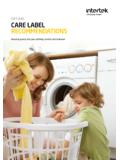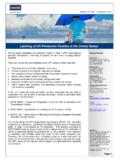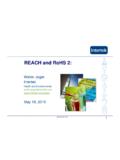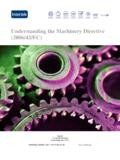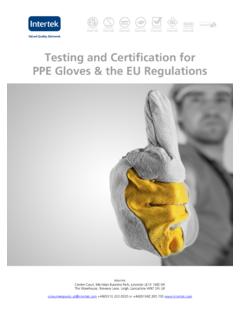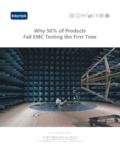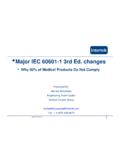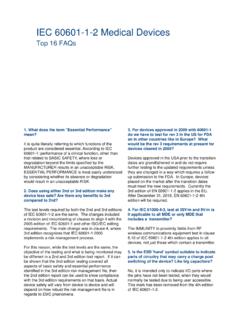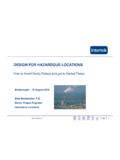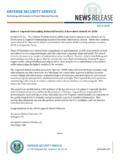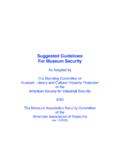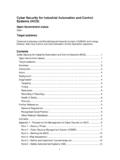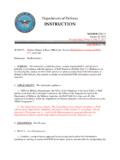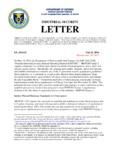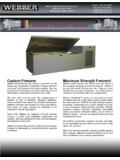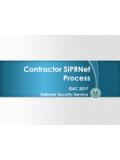Transcription of Industrial Machinery Standards - Intertek
1 Intertek 70 Codman Hill Road Boxborough, MA 01719 1-800-WORLDLAB Industrial Machinery Standards : NFPA 79 for the US in comparison to IEC / EN 60204-1 for Europe (2016 Edition) Industrial Machinery Standards : NFPA 79 for the US in comparison to IEC / EN 60204-1 for Europe 1 Introduction Every year, European manufacturers export thousands of electrical products to the US. Sometimes these products are unwittingly non-compliant simply because European manufacturers are unfamiliar with the equipment rules that apply in the individual US states, or that are required by specific Authorities Having Jurisdiction (AHJs) and the Occupational Safety and Health Administration (OSHA). Building a compliance programme that accommodates the wide variety of requirements from different US institutions is complex and sometimes confusing. A manufacturer s lack of understanding of local and national US laws and their implementation can lead to some requirements being overlooked which can delay product entry at port eating into the sales calendar.
2 A simple non-compliance that could have been resolved with a design tweak before release could be missed and the equipment later needs to be recalled or modified as a result. To help manufacturers of Machinery and equipment make sense of the requirements, and reduce the risk of delays through non-conformity and their associated costs, this paper will highlight some of the key differences between the IEC/EN 60204-1:2006 Safety of Machinery Standard and the NFPA 79 Electrical Standard for Industrial Machinery in the US. Although both Standards seem similar, there are significant differences between the two that manufacturers need to consider when preparing Machinery for the US market. Background to the NFPA 79 Electrical Standard for Industrial Machinery The National Fire Protection Association (NFPA) was founded in 1896 and is the issuing body of a comprehensive set of regulations for fire protection having developed and published more than 300 codes and Standards .
3 For manufacturers of Industrial equipment and Machinery , the National Electrical Code (NEC), also known as NFPA 70, and NFPA 79 Electrical Standard for Industrial Machinery are the most important compliance considerations for electrical, mechanical, and plant engineering. The NEC is the standard for the development of public and private building installations that connect to the supply of electricity. The Code is updated every three years and has a high legal status. Each new issue must come from individual federal states and local bodies and these are officially adopted as requirements. Industrial Machinery Standards : NFPA 79 for the US in comparison to IEC / EN 60204-1 for Europe 2 Be aware however, that in different states, different issues of the Code apply. While some are using the current version, others are using previous versions. It is worth checking with your distributors which version of the Code applies locally when trying to plan your compliance activities.
4 You can also check the National Electrical Manufacturers Association (NEMA) Trade Association website which carries a useful territorial map. ( ) Additionally, in some larger cities, local variations to the NEC apply. The local building codes supplement or amend the NEC and should be considered according to your distribution destinations. NFPA 79 vs. EN 60204-1 Despite certain similarities between the two Standards , it is important for European Manufacturers to understand the differences between them as well. For instance, a machine built in accordance with NFPA 79 and supported by appropriate CE Marking documentation could theoretically be placed on the market in Europe. However, a machine built in accordance to EN 60204-1, would not be compliant with NFPA 79, and could not be installed in the US. This is because the requirements of NFPA 79 are significantly more detailed than those of EN 60204-1. Definition of Industrial Machinery The terminology of what constitutes an Industrial machine differs significantly between NFPA 79 and IEC/EN 60204-1.
5 NFPA 79 specifies particular types of equipment and processes. In Chapter 3, section Industrial Machinery (Machine) is defined as: A power-driven machine (or group of machines working together in a coordinated manner), not portable by hand while working, that is used to process material by cutting; forming; pressure; electrical, thermal, or optical techniques; lamination; or a combination of these processes. Machine can include associated equipment used to transfer material or tooling, including fixtures to assemble/disassemble, to inspect or test, or to package. [The associated electrical equipment, including the logic controller(s) and associated software or logic together with the machine actuators and sensors, are considered as part of the Industrial machine.] In section , EN60204-1 gives a more general definition of Machine and Machinery as: assembly of linked parts or components, at least one of which moves, with the appropriate machine actuators, control and power circuits, joined together for specific application, in particular for the processing, treatment, moving or packaging of material.
6 The term Machinery also covers an assembly of machines which, in order to achieve the same end, are arranged and controlled so that they function as an integral whole. Industrial Machinery Standards : NFPA 79 for the US in comparison to IEC / EN 60204-1 for Europe 3 Therefore, equipment that does not fall under this category of Machine in the EU may do so in the US and will need to be assessed accordingly. NB. A device or a small machine is covered in the normal case of a product standard and not by the NFPA 79. Examples include: UL 775 - Graphics Arts Equipment, UL 1740 - Industrial Robots; UL 73 - Motor-operated appliances. Voltage Differences The differences in scope of each document highlight the different applicable voltages between the Standards : Paragraph of the NFPA 79 defines its scope: The provisions of this standard shall apply to the electrical/electronic equipment, apparatus, or systems of Industrial machines operating from a nominal voltage of 600 volts or less, and commencing at the point of connection of the supply to the electrical equipment of the machine.
7 Paragraph 1 of the EN60204-1 defines its scope as: .. applies to the application of electrical, electronic or programmable electronic equipment and systems to machines not portable by hand while working, including a group of machines working together in a co-ordinated manner. Adding, is applicable to electrical equipment or parts of electrical equipment that operate with nominal supply voltages not exceeding 1000 V for alternating current (AC) and not exceeding 1500 V for direct current (DC) with nominal supply frequencies not exceeding 200Hz And adds: ..is applicable to electrical equipment or parts of electrical equipment that operate with nominal supply voltages not exceeding 1000 V for alternating current (AC) and not exceeding 1500 V for direct current (DC) with nominal supply frequencies not exceeding 200Hz Terminology As would be expected, both documents use a great deal of common terminology when describing Machinery (such as actuator, ambient temperature, barrier, and so on though each with a slightly different definition but similar enough to find a degree of parity between the two Standards ).
8 Interestingly, NFPA 79 also specifies definitions for words key to the implementation and understanding of the requirements, whereas EN 60204-1 does not. In Chapter 3 of NFPA 79, compliance terminology is specifically addressed: Approved Acceptable to the Authority Having Jurisdiction. Authority Having Jurisdiction: An organisation, office or individual responsible for enforcing the requirements of a code or standard, or for approving equipment, materials, an installation, or a procedure. Labelled Equipment or materials to which has been attached a label, symbol or other identifying mark of an organisation that is acceptable to the authority having Industrial Machinery Standards : NFPA 79 for the US in comparison to IEC / EN 60204-1 for Europe 4 jurisdiction and concerned with product evaluation, that maintains periodic inspection of production of labelled equipment or materials, and by whose labelling the manufacturer indicates compliance with appropriate Standards or performance in a specified manner.
9 Listed Equipment, materials or services included in a list published by an organisation that is acceptable to the authority having jurisdiction and concerned with the evaluation of products or services, that maintains periodic inspection of production listed equipment or materials or periodic inspection of services, whose listing states that either the equipment, material or services meets appropriate designated Standards or has been tested and found suitable for a specified purpose. Shall Indicates a mandatory requirement Should Indicates a recommendation or that which is advised but not required. Related compliance terminology is defined and explored for European requirements in the Machinery Directive regional legislation that governs the build and use of Machinery in the EU. Industrial Machinery Standards : NFPA 79 for the US in comparison to IEC / EN 60204-1 for Europe 5 Technical Documentation Chapter 17 of NFPA 79 specifies more detailed technical documentation requirements for Machinery than European manufacturers would be familiar with under EN 60204-1.
10 NFPA 79 EN 60204-1 1) Clear, comprehensive description of the equipment, installation and mounting, and the connection to the electrical supply or supplies 1) A main document (parts list or list of documents) 2) Electrical supply circuit(s) requirements 2) Electrical supply or supplies requirements 3) Overview (block) diagram(s) where appropriate 3) Information on the physical environment ( lighting, vibration, atmospheric contaminants) where appropriate 4) Schematic diagram(s) 4) Overview (block) diagram(s) where appropriate 5) Information (where appropriate) on the following: a) programming b) sequence of operation(s) c) frequency of inspection d) frequency and method of functional testing e) adjustment, maintenance and repair f)interconnection diagram g) Panel layouts h) Instruction and service manuals i) Physical environment ( lighting, vibration, noise levels, atmospheric contaminants) 5) circuit diagram(s) 6) A description (including interconnection diagrams) of the safeguards, interacting functions, and interlocking of guards with potentially hazardous motions 6) Information (as applicable) on: Programming as necessary for use of the equipment Sequence of operation(s) Frequency of inspection Frequency and method of functional testing Guidance on adjustment and maintenance, particularly of the protective devices and circuits, Industrial Machinery Standards .

